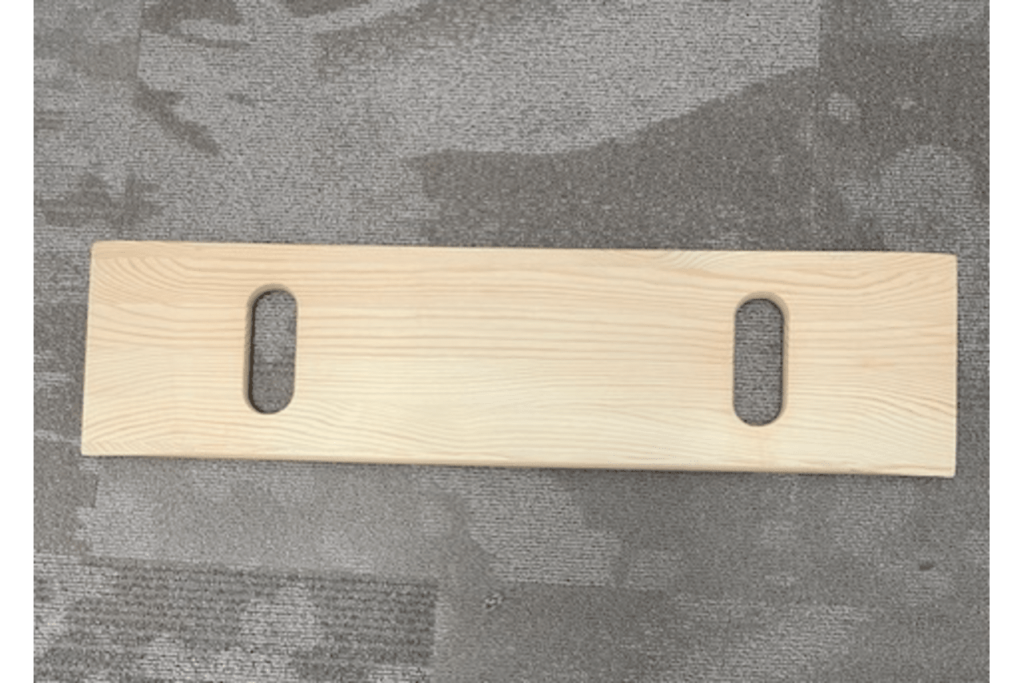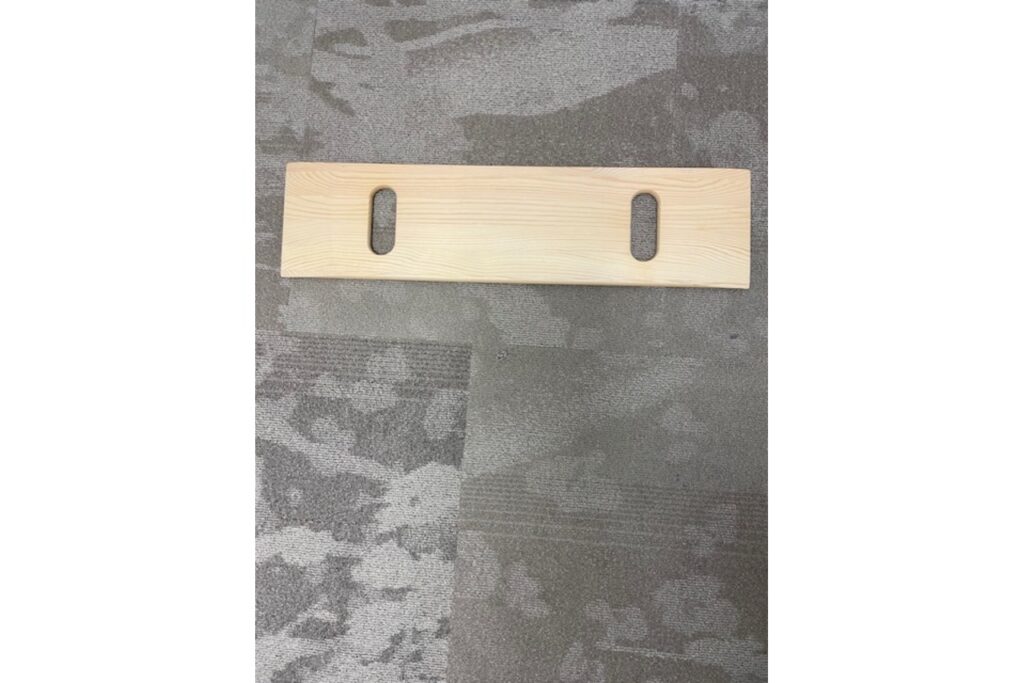Introduction
In occupational therapy, mastering various transfer techniques is crucial. One such technique, the slide board transfer, stands out for its effectiveness and safety. This post is designed to provide comprehensive insights into slide board transfers, making it valuable for both seasoned occupational therapists and those new to the field.
You will learn about the benefits, step-by-step procedures, common mistakes, and tips for optimizing this method. Let’s explore the world of slide board transfers and how they can enhance patient care and safety.
What is a Slide Board Transfer?

A slide board transfer is a technique used to help patients move from one surface to another, such as from a wheelchair to a bed. It involves using a smooth, flat board that acts as a bridge between two surfaces, allowing the patient to slide across with minimal effort and risk.
This technique is particularly useful for patients with limited mobility. The slide board provides stability and reduces the strain on both the patient and the caregiver, making the transfer process smoother and safer.
Benefits of Slide Board Transfers
Enhanced Patient Safety
One of the main advantages of using a slide board transfer is the increased safety it offers. By reducing the need for lifting, the chances of injury to both the patient and the caregiver are significantly minimized. The smooth surface of the slide board ensures that the transfer is controlled and gradual.
Improved Independence
For patients, the slide board transfer can be a step towards greater independence. With proper training, patients can learn to perform transfers with minimal assistance, boosting their confidence and sense of autonomy. This can be particularly empowering for those undergoing rehabilitation.
Versatility Across Settings
Slide board transfers are not limited to specific environments. They can be effectively used in hospitals, rehabilitation centers, and home care settings. This versatility makes them an essential skill for occupational therapists across various healthcare scenarios.
Choosing the Right Slide Board
Material and Durability
When selecting a slide board for transfers, consider the material and durability. Boards made from high-density polyethylene are commonly used due to their strength and resistance to wear and tear. These boards provide a smooth surface that facilitates easy sliding.
Size and Weight Capacity
It’s important to choose a slide board that matches the patient’s size and weight. Boards come in various lengths and widths, and it’s crucial to select one that provides adequate support. Additionally, ensure the board can handle the patient’s weight without compromising safety.
Additional Features
Some slide boards come with additional features such as hand holes or non-slip surfaces. These features can enhance the ease of use and safety during transfers. Hand holes provide a grip for the caregiver, while non-slip surfaces prevent the board from moving during the transfer.
Preparing for a Slide Board Transfer
Assessing the Environment
Before performing a slide board transfer, it’s essential to assess the environment. Ensure that both the starting and destination surfaces are stable and at an appropriate height. Remove any obstacles that might hinder the transfer process.
Positioning the Patient
Proper positioning of the patient is critical for a successful transfer. The patient should be seated on the edge of the starting surface, with their feet flat on the ground. Their body should be slightly leaning forward to facilitate sliding.
Placement of the Slide Board
Place one end of the slide board under the patient’s buttocks and the other end on the destination surface. Ensure that the board is securely positioned and there is no gap between the surfaces. A slight downward angle can help in making the slide smoother.
Performing the Slide Board Transfer

Step-by-Step Guide
- Stabilize the Board:
Make sure the slide board is firmly in place. You can use your hand to hold the board steady if necessary.
- Guide the Patient:
Instruct the patient to place their hands on the slide board for support. Assist them in shifting their weight onto the board.
- Initiate the Slide:
Gently guide the patient to slide across the board. Encourage them to use their arms to assist in the movement. Move slowly and steadily to ensure a controlled transfer.
Common Mistakes to Avoid
Avoiding common mistakes is essential for a successful slide board transfer. Ensure that the board does not slip during the transfer. Also, avoid lifting the patient; the goal is to slide, not lift. Lastly, maintain clear communication with the patient throughout the process.
Tips for Smooth Transfers
For a smoother transfer, use a cloth or towel under the patient to reduce friction. Encourage the patient to use their arms to push themselves along the slide board. Practice and patience are key to mastering this technique.
Ensuring Patient Comfort
Using Padding
To enhance patient comfort during the transfer, consider using padding on the slide board. A towel or cushion can provide additional support and reduce pressure points.
Communication and Reassurance
Clear communication is essential for patient comfort. Explain each step of the transfer process and reassure the patient throughout. This helps in reducing anxiety and ensuring a smooth transfer.
Adjusting Techniques
Every patient is different, and it’s important to adjust your technique based on individual needs. Pay attention to the patient’s feedback and make necessary adjustments to improve comfort and efficiency.
Post-Transfer Care
Checking for Discomfort
After the transfer, check the patient for any signs of discomfort or pain. Address any issues immediately to prevent complications. Ensuring the patient is comfortable after the transfer is as important as the transfer itself.
Proper Positioning
Ensure that the patient is properly positioned on the destination surface. Their body should be aligned and supported to prevent strain or injury. Use cushions or supports if necessary.
Documenting the Transfer
Documenting the transfer process is essential for tracking progress and identifying areas for improvement. Note any challenges or issues encountered during the transfer and communicate them with the healthcare team.
Training for Slide Board Transfers
Educating Caregivers
Training caregivers in the proper use of slide board transfers is crucial. Provide comprehensive education on the technique, including hands-on practice and demonstrations. This ensures consistent and safe transfers.
Patient Training
If the patient is capable of performing slide board transfers independently, provide thorough training. Teach them the correct technique and supervise their practice sessions until they are confident and proficient.
Continuous Learning
Encourage continuous learning and improvement. Stay updated on the latest techniques and advancements in slide board transfers. Regularly review and refine your skills to ensure the best patient care.
Incorporating Slide Board Transfers in Different Settings
Hospitals and Rehabilitation Centers
In hospitals and rehabilitation centers, slide board transfers can facilitate the movement of patients between the bed, wheelchair, chair, shower chair and the toilet.
Home Care
For patients receiving home care, slide board transfers can enhance mobility and independence. Caregivers can use this technique to assist patients in moving between various surfaces within the home.
Long-Term Care Facilities
In long-term care facilities, slide board transfers can improve the quality of life for residents. They provide a safe and efficient method for transferring residents, reducing the risk of falls and injuries.
Enhancing Patient Independence with Slide Board Transfers
Gradual Skill Building
Encourage patients to gradually build their skills in performing slide board transfers. Start with simple transfers and progressively move to more complex ones as the patient gains confidence and proficiency.
Providing Supportive Tools
Provide patients with supportive tools such as grab bars and transfer belts. These tools can enhance safety and ease during the transfer process, promoting greater independence.
Celebrating Achievements
Acknowledge and celebrate the patient’s achievements in mastering slide board transfers. Positive reinforcement boosts confidence and motivates patients to continue improving their skills.
Conclusion
Mastering slide board transfers is essential for occupational therapists aiming to provide the highest level of care. This technique not only enhances patient safety and independence but also offers versatility across various healthcare settings.
By understanding the benefits, choosing the right slide board, and following proper procedures, you can ensure successful and comfortable transfers for your patients. Continuous learning and adaptation are key to optimizing this technique and improving patient outcomes.
The information provided on this website is for general informational purposes only. It is not intended as, nor should it be considered, professional or medical advice. Always consult a professional regarding your specific medical issue.
Frequently Asked Questions About Slide Board Transfer
What is a slide board transfer?
A slide board transfer is a technique used to move individuals with limited mobility from one surface to another, such as from a wheelchair to a bed. It involves using a smooth, flat board to bridge the gap between the surfaces, allowing the individual to slide across safely.
Who can benefit from using slide board transfers?
Slide board transfers are beneficial for patients with limited strength or balance, those recovering from surgery or injury, and individuals with disabilities that affect mobility. This technique promotes safe transfers and helps reduce strain on both the patient and caregiver.
How do I choose the right slide board?
Selecting the appropriate slide board involves considering factors like the patient’s weight, the distance between transfer surfaces, and the materials of the board. Boards come in various lengths and materials, such as plastic or wood, and some may have handles for added stability.
Can slide board transfers be performed independently?
Yes, with proper training and practice, some patients can perform slide board transfers independently. It requires a certain level of upper body strength and the ability to balance. It is essential to assess the patient’s capability before encouraging independent transfers.
Are there any risks associated with slide board transfers?
While slide board transfers are generally safe, there are risks of skin irritation or bruising if not executed properly. Ensuring the board is positioned securely, maintaining clear communication, and using proper techniques can mitigate these risks.
References
- Smith, J.A., & Brown, L.K. (2021). Techniques in Occupational Therapy: Enhancing Patient Mobility. New York: Health Press. This comprehensive guide provides detailed insights into various transfer techniques, including slide board transfers, aimed at improving patient mobility and safety.
- Jones, M.C., & Davis, R. (2020). “Slide Board Transfers: Best Practices and Innovations.” Journal of Rehabilitation Research and Development, 57(3), 154-162. This article reviews the latest advancements in slide board transfer techniques, focusing on innovations that enhance effectiveness and patient independence.
- American Occupational Therapy Association (AOTA). (2019). Occupational Therapy Practice Framework: Domain and Process (4th ed.). Bethesda, MD: AOTA Press. This framework outlines the principles and methods used in occupational therapy, including patient transfer techniques.
- Johnson, T., & White, H. (2018). “Safe Patient Handling in Healthcare Settings.” International Journal of Nursing Studies, 55, 89-97. This study explores safe handling practices across healthcare settings, emphasizing the importance of proper training and technique in slide board transfers.
- Thompson, S., & Lewis, P. (2017). Adaptive Equipment in Occupational Therapy: Methods and Applications. Boston: Learning Solutions. This book provides practical applications and descriptions of adaptive equipment, including slide boards, that are useful for occupational therapists to support patient care.
Recently Featured OT Insider Posts
QHS Medical Abbreviation: Everything You Need to Know
Contact Hours vs CEUs: What Professionals Need to Know
Platform Walker: How to Use Guide in Occupational Therapy
Therapeutic Use of Self for Transformative Occupational Therapy
OT Frames of Reference: Practical Applications for Patient Care
Inpatient Occupational Therapy: How it Works to Revitalize Lives
KELS Assessment: How to Use it to Unlock Independence
